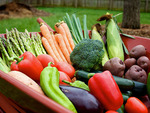
Madison Wisconsin Chiropractor Newsletter
Our free monthly e-newsletter is designed to be used as a resource for our patients in discovering and empowering them to make the best choices for their health and wellbeing.
4200 University ave.
suite 2100
Madison WI 53705
Phone 1: 608-231-3900
LaRoy D Reek D.C.
email - website
Bee Pollen Benefits
rd411.com
[ read article ]
Bountiful and Delicious: Healthy Harvest Foods
rd411.com
[ read article ]
The Importance of Preventative Chiropractic Care
Nick Messe
[ read article ]
Antioxidants: Do You Know What They Are?
nutrition411.com
[ read article ]
Bountiful and Delicious: Healthy Harvest Foods
rd411.com
website
 When you think of autumn, you most likely envision the beautiful orange, yellow, and red hues of the season. Stroll down the produce aisle of your neighborhood grocery store and discover those same vibrant colors in the form of seasonal vegetables and fruits, such as pumpkins, squash, and apples. Best of all, these harvest foods also are packed with nutritional value. Encourage those you care for to try some new and different varieties of fall produce this year and give them the gift of health along the way!
When you think of autumn, you most likely envision the beautiful orange, yellow, and red hues of the season. Stroll down the produce aisle of your neighborhood grocery store and discover those same vibrant colors in the form of seasonal vegetables and fruits, such as pumpkins, squash, and apples. Best of all, these harvest foods also are packed with nutritional value. Encourage those you care for to try some new and different varieties of fall produce this year and give them the gift of health along the way!Winter squash and pumpkins (both members of the gourd family) come in a wide variety of colors and sizes. They are becoming increasingly popular because of their versatile use in both sweet and savory recipes, and they are good sources of complex carbohydrates, vitamins, and minerals. Pumpkins are especially good sources of alpha- and beta-carotene, beta-cryptoxanthin (an antioxidant), vitamin C, riboflavin, and iron. Cooking pumpkins (also known as sugar pumpkins or pie pumpkins) are delicious in pies, cookies, custards, and soups. Their seeds are easily toasted for a crunchy high-fiber snack. The seeds are great eaten by the handful or added to fruit and vegetable salads. Pumpkin and squash seeds contain phytosterols; vitamins, including folate, tocopherols, and carotenoids; and minerals, including phosphorus, selenium, and zinc. (Pumpkin seed is approved as an herb by the German Commission E.)
Bright orange and yellow squash contain significant amounts of carotenes, as well as some lutein and zeaxanthin (antioxidants). Butternut squash is good sliced, stewed, boiled, or baked in a pie. It is a particularly good source of calcium, magnesium, and carotenes. Spaghetti squash makes a wonderful casserole or side dish. Try it with tomato sauce in place of traditional spaghetti. Acorn and Hubbard squash are particularly good sources of potassium and fiber. Acorn squash also is high in thiamine.
Apples come in countless varieties, each with its own color, flavor, and texture. While some types of apples such as Golden or Red Delicious are best for eating fresh and crisp, other varieties such as Crab, Bramley, and Jonathan apples are best for cooking in pies, cakes, crisps, and chutneys. Look for sauce, butter, pickle, and relish recipes that include apples. Apples are powerhouses of flavonoids, such as quercetin, as well as a great source of cholesterol-lowering phytosterols. Apples also are a good source of vitamin C, beta-carotene, beta-cryptoxanthin, lutein, and zeaxanthin. In addition, apples with their skins are one of the best known sources of pectin - a type of soluble fiber shown to help reduce cholesterol. Try making tea by steeping oven-roasted and dried apple slices for an old-fashioned hot beverage.
Fruit and vegetable tips
▪ Thoroughly wash all vegetables and fruit, as you would any produce, before eating or cooking to destroy any bacteria and to remove any pesticides or herbicides from their surfaces.
▪ Select produce without soft spots, blemishes, or cuts.
▪ Eat fruits and vegetables fresh or lightly cooked to obtain the most nutrient value. Avoid boiling when possible.
▪ Experiment with a variety of spices, herbs, and cooking methods. Enjoy the outdoors
Autumn's cool weather and beautiful foliage is a call from nature to get outside, enjoy the scenery, and get physically active. One great event for fun family fitness is visiting a pumpkin patch and picking your own pumpkins and gourds. In addition, many pumpkin patch locations feature other activities, such as corn mazes and hayrides. The following link can help you find a pumpkin patch near you: www.pumpkinpatchesandmore.org.
If you like this type of outdoor activity, you may wish to also visit this link: www.pickyourown.org to find farm locations in your area that allow visitors to pick their own fruits or vegetables. Whether picking apples, pears, squash, peppers, or sweet potatoes, this is great way to connect with nature, burn some calories, and come home with healthy, nutritious foods. Try canning to preserve your favorite varieties for the rest of the year, or grow your own harvest fruits and vegetables and enjoy eating them even more.
Integrated with Madison Wisconsin's Meriter Hospital and Turville Bay MRI center for diagnostic testing. Focused on quick accurate care for patient relief. Dr. Reek has practiced in Madison Wisconsin and helped thousands of patients just like you in his 19 years of professional practice. He is highly trained in the diagnosis and treatment of neck, back and soft tissue injuries. His office in Madison, WI, uses the latest technology to provide you with the best possible health care. Dr. Reek will consult with you. He will provide his opinion on your condition and discuss what options are available for you. If appropriate, he will refer you to other Madison health care experts including Neurologists, Orthopedists and Acupuncturists. When necessary, Dr. Reek will refer patients to Turville Bay MRI or utilize his hospital privileges at Madison's Meriter Hospital.